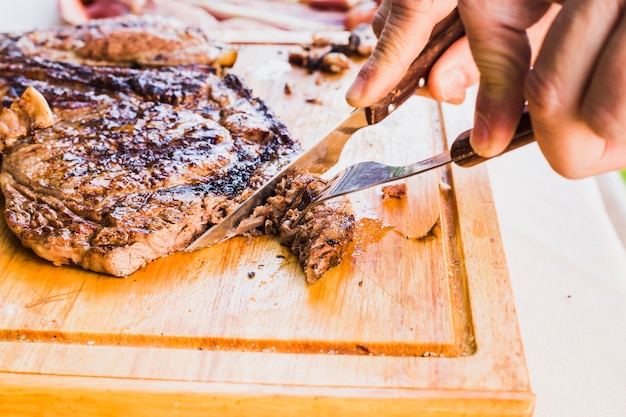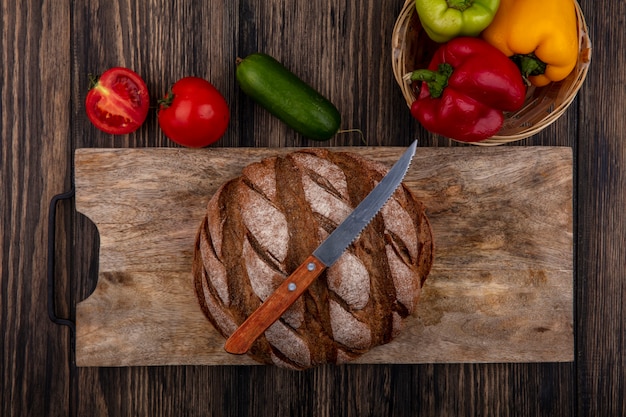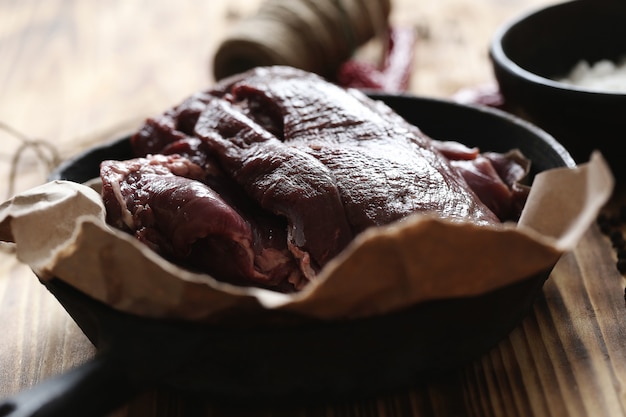Ah, prime rib. The king of roasts, the ultimate BBQ showstopper. The mere mention of it conjures up images of succulent, pink-hued meat, glistening with juices, and sporting a gloriously crisp crust. It's a dish that screams "celebration," and rightly so! But, before you dive headfirst into the world of prime rib grilling, let's clear the air: it's not just about throwing a hunk of meat on the grill and hoping for the best. There's a method, a rhythm, a whole symphony of techniques that go into crafting a truly exceptional prime rib experience. And believe me, when you get it right, the rewards are oh so sweet.
So, gather 'round, my fellow grill enthusiasts, because we're about to embark on a journey to grill mastery. From choosing the perfect cut to mastering the art of low and slow cooking, we'll cover it all. Get ready to elevate your BBQ game to a whole new level.
(Part 1) Choosing Your Prime Rib: A Prime Decision

The Cut That Makes All the Difference
First, let's address the elephant in the room: the cut. Forget the confusing jargon at the meat counter, we're sticking to the classics. Your quest begins with a "standing rib roast," also known as a "prime rib roast." It's a magnificent section of ribs with the bone intact, and believe me, that bone plays a crucial role in the drama. It's the foundation for that melt-in-your-mouth tenderness and adds a unique flavour dimension. Think of it as the conductor of the meat symphony.
Size Matters: A Feast for the Masses
Now, let's talk size. This depends entirely on the number of hungry souls you're feeding. For a family meal, a 3-4 bone roast is a perfect companion. But if you're hosting a grand gathering, go for a 5-7 bone behemoth. Remember, prime rib is meant to be shared, so don't be shy about going big!
Don't Be Afraid of Fat: The Secret to Juicy Deliciousness
Here's a piece of wisdom that might surprise you: embrace the fat! The fat is not the enemy, it's your secret weapon. It's the source of juicy, flavourful meat. Look for a roast with good marbling, those intricate strands of fat interspersed throughout the meat. And don't shy away from a generous layer of fat on the outside. This is what renders down to create those mouthwatering juices and keeps your roast from drying out. Feel free to trim a bit if you're worried, but remember, fat equals flavour!
(Part 2) Prepping for Prime Time: A Ritual of Flavour

The Salt Cure: A Dry Brine for Maximum Juiciness
One of the beautiful things about prime rib is its forgiving nature. You can even start the flavour journey a day in advance with a dry brine. It's a simple but powerful technique that elevates the entire experience. Pat your roast dry, then generously rub it with kosher salt. The salt draws out moisture, which then gets reabsorbed, making the meat incredibly juicy and tender. Pop it in the fridge uncovered for 12-24 hours, and let the magic unfold. You'll be amazed by the difference it makes!
Spice it Up: A Symphony of Seasonings
Now it's time to get creative! The world of seasonings is your oyster. I personally adore a classic blend of salt, pepper, garlic powder, and onion powder. It's simple, yet so effective. But don't hesitate to explore other flavour profiles. Experiment with herbs like rosemary, thyme, or oregano for an earthy touch. Or go bold with a spicy rub using paprika, cayenne, and chili powder. The beauty of prime rib is that it can handle anything you throw at it!
The Big Reveal: A Final Touch of Magic
After the salt cure, your roast will have a lovely, dry crust. Pat it down once more, and get ready for the final touch - your chosen seasoning blend. I prefer to apply it right before grilling, as it helps create that irresistible crispy crust during cooking. It's the finishing touch, the perfect finale to your flavour symphony.
(Part 3) Mastering the Grill: A Low and Slow Dance

Setting the Stage: A Symphony of Heat
Prime rib is not a dish for rushing. It thrives on slow, gentle cooking, a symphony of heat that creates a melt-in-your-mouth masterpiece. So, set your grill up for indirect heat. If you're using charcoal, arrange the coals on one side of the grill, leaving the other side empty. If you're using gas, turn on the burners on one side and leave the other off. This creates a "hot" zone for searing and a "cool" zone for slow cooking, ensuring even cooking and a beautiful, juicy result.
Temperature is Key: Finding the Sweet Spot
The ideal temperature for prime rib is around 225°F (107°C). Think of it as a warm embrace, allowing the meat to cook slowly and evenly. Keep a watchful eye on your grill thermometer and adjust the heat as needed.
The Time is Right: A Matter of Patience
Here's where things get a little more nuanced. cooking time depends on the size of your roast and the level of doneness you crave. A good starting point is 15-20 minutes per pound for medium-rare. But remember, this is just a guideline. Always rely on your trusty meat thermometer to ensure the meat is cooked to perfection.
A Time for Rest: A Moment of Indulgence
Once your prime rib reaches its desired internal temperature (around 130-135°F for medium-rare), it's time to take it off the grill and let it rest. At least 30 minutes, covered loosely with foil, in a warm spot. This allows the juices to redistribute throughout the meat, preventing dryness and ensuring a symphony of flavour in every bite.
(Part 4) Carving the Masterpiece: A Performance of Precision
Sharpen Your Tools: A Symphony of Blades
Now, the moment of truth. Grab a good, sharp carving knife, the instrument that will unlock the treasure within. Make sure your carving board is sturdy and large enough to hold your masterpiece comfortably.
The Art of Carving: A Dance of Skill
Start by carving off the fat cap, which should have rendered down beautifully during cooking. Then, carve the roast perpendicular to the bone, creating thin slices. You can remove the bone, but if you're feeling adventurous, leave it in for a rustic, dramatic presentation.
Feast Your Eyes and Stomach: A Culinary Encore
Step back and admire your creation. That beautiful, pink-hued meat, with its crispy crust and glistening juices, is a testament to your dedication. It's a symphony of flavour, a visual feast, and a culinary masterpiece. Now, it's time to savor the fruits of your labour!
(Part 5) side dishes to Compliment the King: A Cast of Supporting Stars
Starchy Companions: A Symphony of Textures
Prime rib deserves a stellar supporting cast of side dishes. My personal favourite is roasted potatoes. Simple, flavourful, and the perfect complement to the rich, juicy meat. Toss them with olive oil, salt, pepper, and your favourite herbs, and roast them until golden brown and crispy on the outside. It's a symphony of textures that elevates the entire experience.
Green Goodness: A Symphony of Freshness
For a refreshing counterpoint, a green salad is essential. A simple mix of greens, cherry tomatoes, red onion, and a light vinaigrette is a perfect way to cut through the richness of the prime rib. You can also add grilled asparagus, broccoli, or corn on the cob to your side dish lineup for a touch of earthy sweetness.
Sweet and Savoury: A Symphony of Contrasts
For a touch of sweetness, try a baked sweet potato. It's not just delicious, it adds a splash of colour to your table. Feel free to add a dollop of honey or maple syrup for extra sweetness. It's a delightful contrast to the savoury prime rib.
(Part 6) Beyond the Basics: Elevating the Experience
Au Jus, Oh My!: A Symphony of Flavours
Let's talk gravy! Au jus, a rich and flavourful broth made from the drippings of the roast, is a classic companion to prime rib. To make it, simply strain the drippings from the roasting pan, add a little water or beef stock, and simmer until it reduces slightly. You can also add cornstarch to thicken it up. It's a simple touch that adds a layer of complexity and richness to your dish.
Yorkshire Pudding: A Savoury Symphony
For those seeking a more adventurous experience, try making Yorkshire pudding. This savoury bread pudding, made with eggs, milk, and flour, is a traditional companion to roast beef. It's fluffy, golden brown, and absorbs all the delicious juices from the roast. It's a culinary masterpiece that adds a touch of elegance to your meal.
Don't Forget the Sauce: A Symphony of Accompaniments
Prime rib also pairs beautifully with a variety of sauces. A simple horseradish sauce, a tangy chimichurri, or a classic béarnaise are all excellent choices. Each adds its own unique flavour profile, creating a symphony of tastes that will tantalize your taste buds.
(Part 7) FAQs: Addressing Your Culinary Concerns
You've got questions, I've got answers. Here are some of the most common questions about grilling prime rib:
1. What temperature should prime rib be cooked to?
The internal temperature of your prime rib should reach 130-135°F for medium-rare, 140-145°F for medium, and 150-155°F for medium-well. Always use a meat thermometer to ensure the meat is cooked to your liking.
2. How long should I cook prime rib on the BBQ?
A good rule of thumb is to cook a prime rib roast for 15-20 minutes per pound for medium-rare. However, this can vary depending on the size of your roast and the temperature of your grill. It's always best to err on the side of caution and use a meat thermometer to confirm doneness.
3. Can I cook prime rib on a gas grill?
Absolutely! You can cook prime rib on a gas grill by setting up indirect heat. Turn on the burners on one side of the grill and leave the other side off. This creates a warm zone for cooking and a cooler zone for resting, mimicking the effect of a charcoal grill.
4. How do I prevent prime rib from drying out?
The key to preventing prime rib from drying out is to cook it slowly and evenly over indirect heat. Also, make sure to let the roast rest for at least 30 minutes after cooking, allowing the juices to redistribute throughout the meat.
5. Can I freeze prime rib?
Yes, you can freeze prime rib. Wrap it tightly in plastic wrap and then in foil, and freeze for up to 3 months. Make sure to thaw the roast in the refrigerator for 2-3 days before cooking. This ensures that the meat thaws evenly and doesn't dry out during the process.
(Part 8) Conclusion: A Feast for the Senses
There you have it, my friends, the ultimate guide to grilling a perfect prime rib. It might seem like a lot of steps, but trust me, it's worth every bit of effort. The result is a meal that's both impressive and delicious, a celebration of good food, good company, and the joy of cooking over fire. So, next time you're looking for a showstopper, remember what you've learned here. Grab a prime rib, fire up the grill, and get ready for a culinary adventure that will leave everyone wanting more.
Happy grilling!
Everyone is watching

Corn on the Cob: The Ultimate Guide to Perfectly Cooked Ears
Healthy MealsAh, corn on the cob. Just the name evokes images of sunny days, barbecues, and that sweet, juicy flavour that ...

Scallops: The Ultimate Guide to Perfect Cooking
Healthy MealsAh, scallops. Those delicate, sweet, and utterly delicious morsels of the sea. They hold a special place in my...

Spaghetti Squash: The Ultimate Guide to Cooking and Serving
Healthy MealsRemember that time you saw spaghetti squash at the supermarket, looking all bumpy and strange, and thought, "W...

Salmon Cooking Times: Perfect Guide for Every Recipe
Healthy MealsLet me tell you, cooking salmon is an art form. It's all about getting that perfect balance: juicy and tender,...

Ham Cooking Time: How Long to Bake, Smoke, or Boil a Delicious Ham
Healthy MealsAh, ham. It's a classic, isn't it? A real crowd-pleaser, especially around holidays. And when done right, it'...
